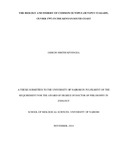| dc.description.abstract | Although common octopus catches are increasing globally, lack of information on the species
biology and fishery has been a major concern in its management particularly in Kenya. The present
study aimed at investigating the fishery, reproductive and feeding biology of common octopus from
Shimoni and Vanga which are some of the major fish landing sites in the Kenyan South coast.
Sampling was done monthly from November 2010 through November 2012 using traditional fishing
spear ‘mkuki’ or ‘shomo’. For each specimen, body weight (BW), total length (TL), dorsal mantle
length (DML), ventral mantle length (VML) and gonad weights were recorded. Maturity stages and
Gonadosomatic Index (GSI) were determined using standard methods. Stomach content analysis was
determined using both the frequency of occurrence method and the dominant (numerical) method.
For the processing and markets of common octopus, information was collected from logbook
records, and landings from fishermen and fish industries.
A total of 1,599 specimens were collected, 746 males and 853 females. The size distribution range of
the females varied between 5.40 cm and 24.50 cm DML and from 0.07 kg to 5.50 kg BW, while the
DML of males ranged from 5.80 to 18.50 cm and the BW from 0.08 kg to 3.95 kg. The monthly
mean DML values ranged between 9.52 ± 1.81cm and 13.53 ± 2.51cm at Shimoni and 9.14 ± 1.56
cm to 13.00 ± 2.36 cm at Vanga. The monthly mean DML and BW values showed a decreasing
trend over the two-year period, an indication that octopus population was under high exploitation
pressure. The sex ratio was 1:1.1 (males: females) for both Shimoni and Vanga during the study
period. However, there was no seasonal or annual significant
of females. The female length at first maturity was 10.8 cm (DML 50%), while for the male was 10.5
cm (DML 50%), respectively. There was no significant difference, statistically between female and
male length at first maturity. The common octopus preferred crustaceans (mainly crabs) to other food
items and its diet preference was not influenced by seasons. The processing of octopus was done
using both traditional techniques and modern facilities that are fully compliant with the food safety
standards for export markets. The value-added octopus final products ranged from traditional dried
octopus to chilled and frozen packed octopus. The species was marketed fresh, frozen and dried,
mostly for human consumption. A small local market was found to exist for common octopus of
which most of it was sold in local seafood tourist restaurants. International markets existed in various
countries including Italy, Spain, France and Portugal. The scientific information gathered during this
study on the fishery, reproductive and feeding biology of common octopus will go a long way in
informing policy directions and the management of octopus in Kenya.
Key words: common octopus, fishery, reproductive, feeding, Shimoni, Vanga. | en_US |

